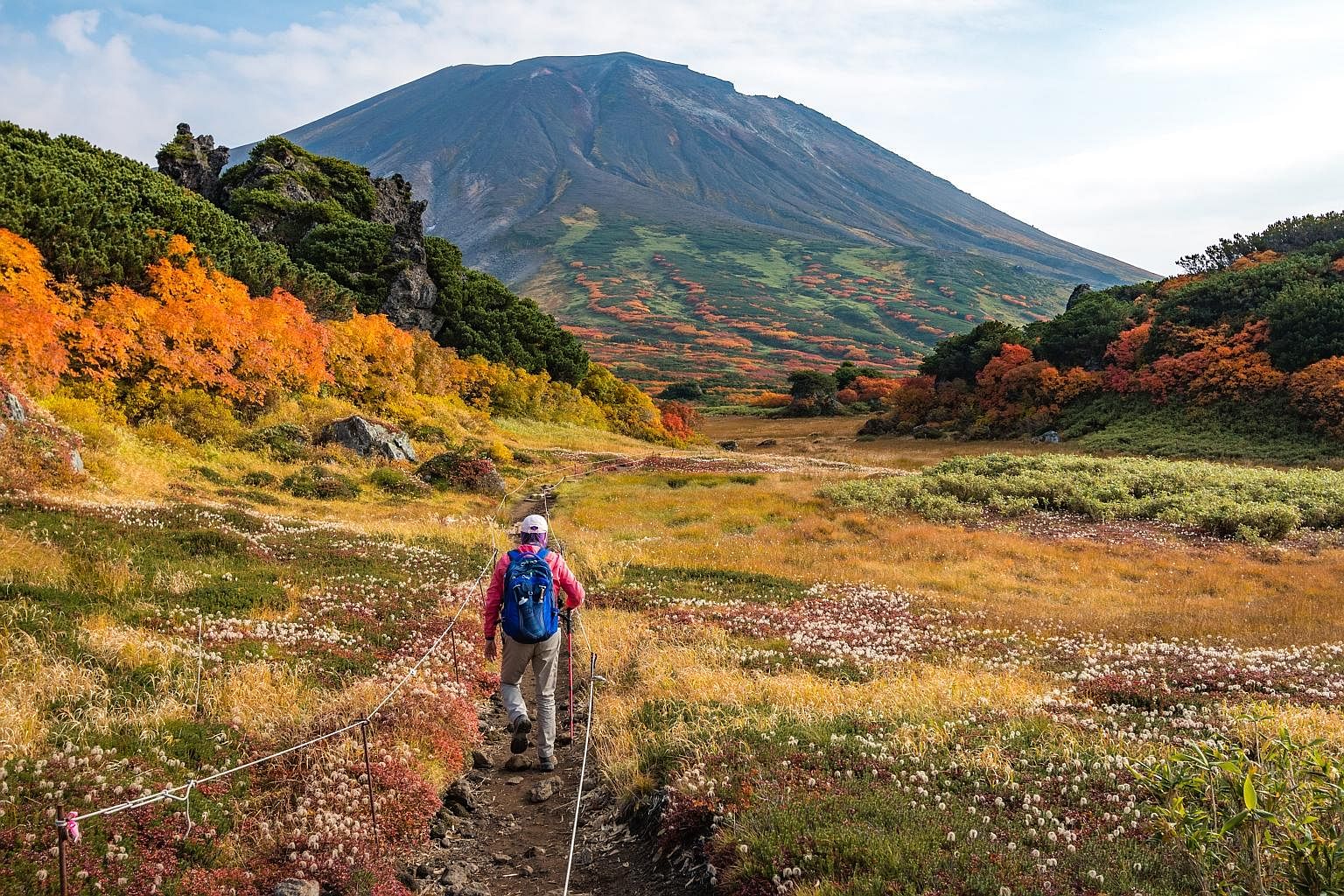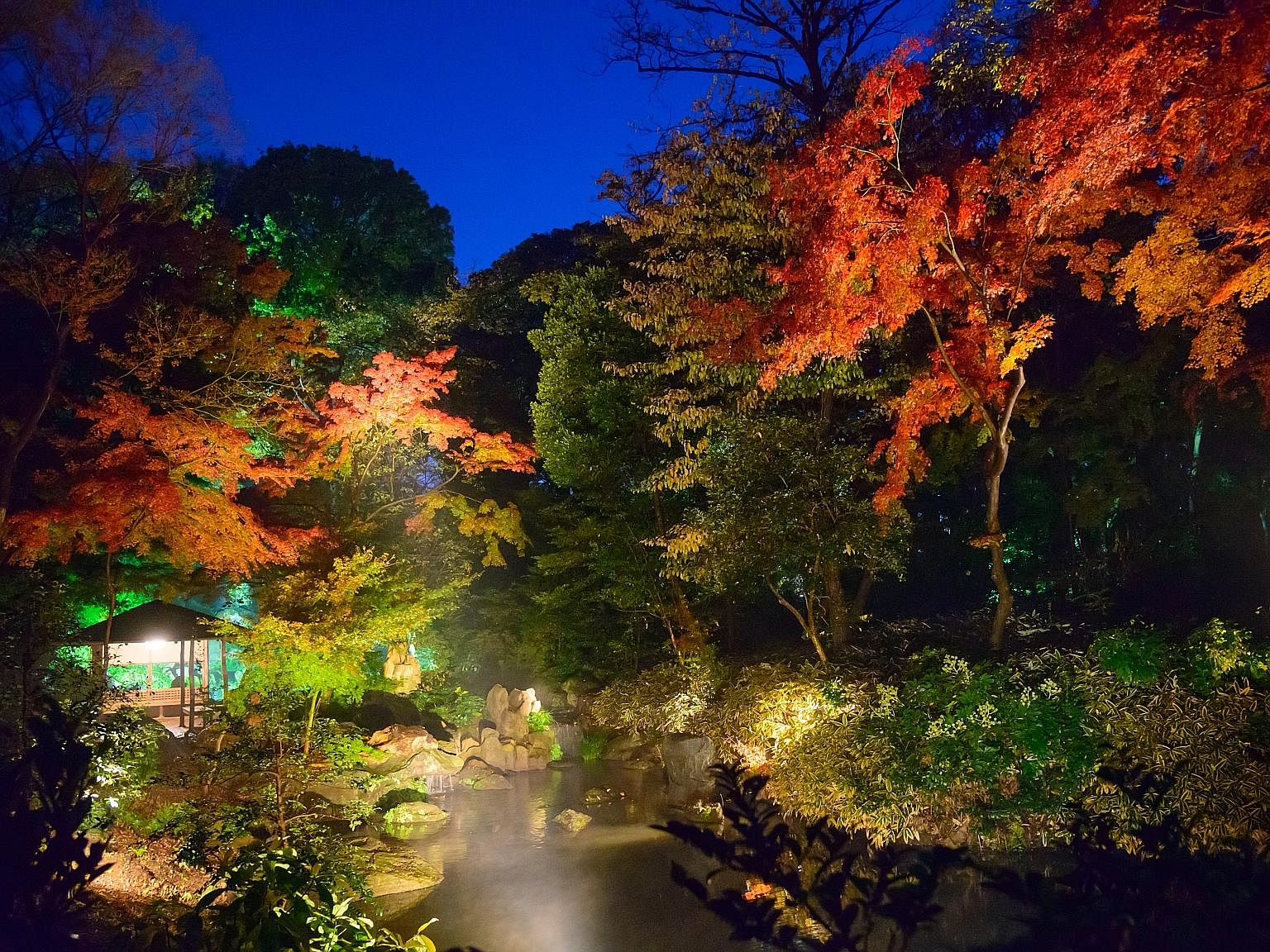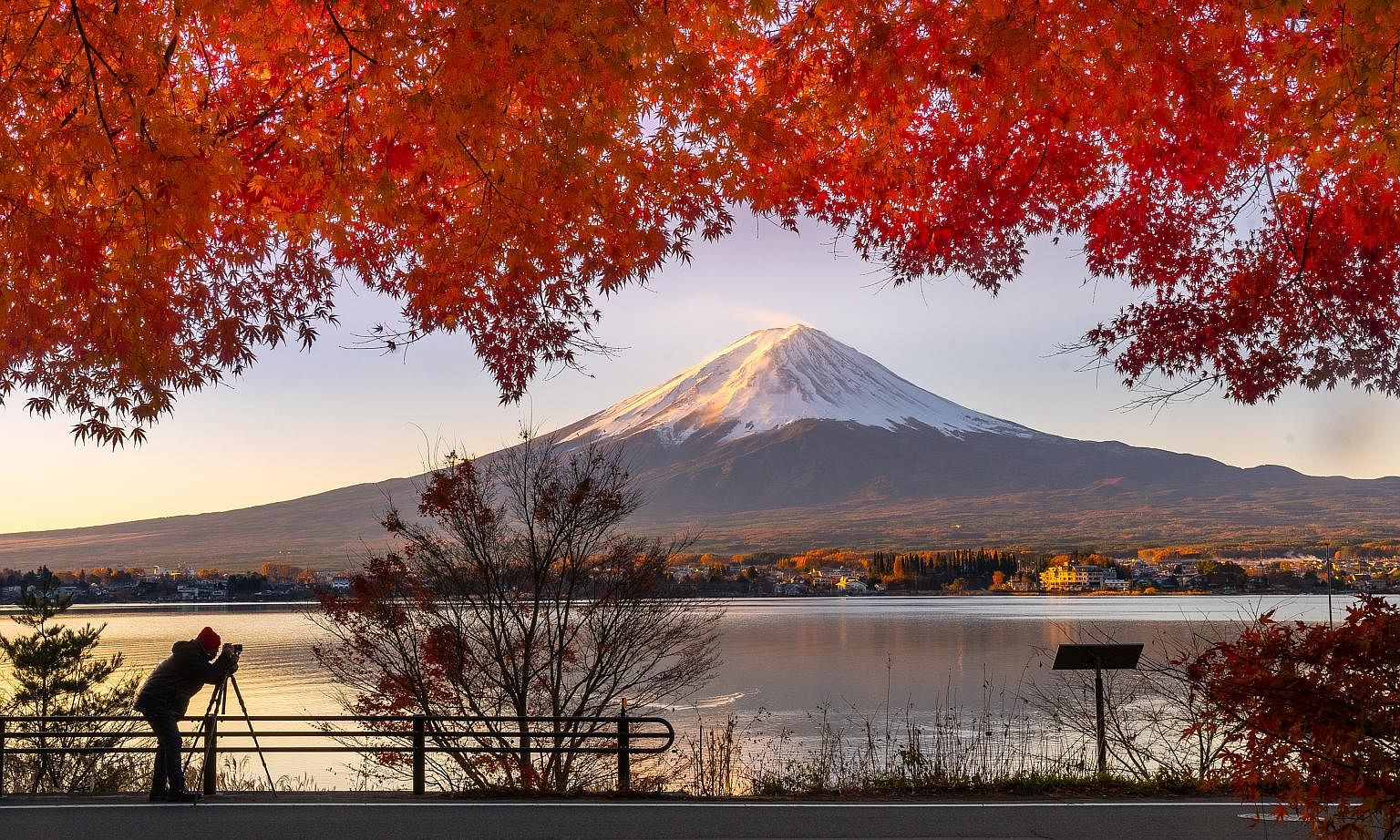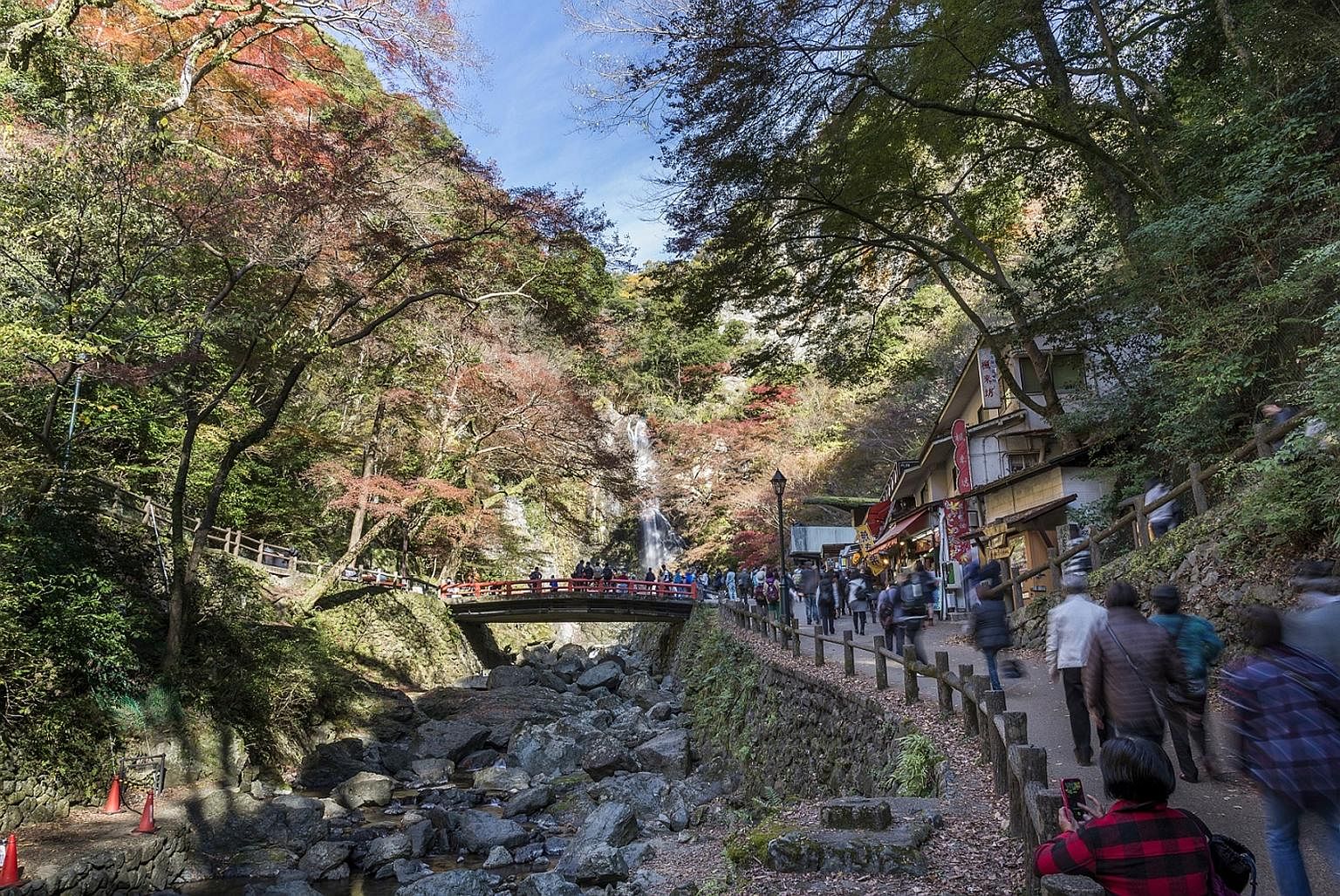As summer ends and autumn beckons, the colours of the leaves slowly transform into vivid shades of red, yellow and orange.
The turning of the leaves in Japan is a major draw for not only holidaymakers, but also the locals, who plan their drives, hikes and picnics to coincide with the best viewing times.
Beyond the usual fall foliage hot spots, which are packed with visitors during the season, many parks in the big cities also offer incredible views of trees awash in vibrant hues.
Unhurried train rides across Japan, starting in the north and heading down south, are also a fuss-free way to see the country in all its seasonal glory.
If you are looking to explore the entirety of Japan, you can do so with a cost-effective JR Whole Japan Rail Pass, which gives access to an extensive network of train lines.
Here are some must-see autumn foliage destinations.
• This story was brought to you by travel activities and services booking platform Klook.
Sagano Scenic Railway and Tofukuji Temple, Kyoto
For a memorable experience, embark on a leisurely ride on the Sagano Scenic Railway.
The sightseeing train in Kyoto has come to be known as the romantic train, as it takes passengers through dreamy and breathtaking scenery.
The sights along the line change with the seasons. In spring, cherry blossoms sway above the passing train. In autumn, the landscape is wrapped in a blanket of flaming orange and crimson red leaves.
The train winds its way through the sun-dappled forests at a relatively slow pace. It takes 25 minutes to make the journey between Saga Station and Kameoka Station.
While the scenic railway is not covered by the Japan Rail Pass, the ride is worth the extra cost. One-way tickets can be bought from the counters for 620 yen (S$8.10) for adults.
During autumn, however, there may be long queues for the train ride, so book your tickets in advance.
You can begin your journey from the Torokko Saga Station. This station is right next to the JR Saga-Arashiyama Station, which can be easily reached from Kyoto Station on the Sagano Line.
If you are in Kyoto, why not stop by the Tofukuji Temple?
The zen temple is known not only for its historical halls, but also for the lush maple trees which are a blaze of fiery red in the fall. The temple grounds can get extremely crowded with foliage hunters then.
It is a 10-minute walk from Tofukuji Station, just a stop away from Kyoto Station on the JR Nara Line.
Daisetsuzan National Park, Hokkaido

Hokkaido, the first place in Japan where autumn descends, is the ideal launchpad to the rest of the country.
The fall foliage season usually peaks in October on the northernmost island. In other parts such as Tokyo and Kyoto, the best viewing times range between November and December.
Kick-start your foliage hunt with a visit to the Daisetsuzan National Park, said to be the first spot to see the changing colours of the leaves each autumn.
The park in central Hokkaido takes you through an unspoilt landscape of mountain ranges, hot spring resorts and waterfalls. It is also home to plenty of alpine plants and wildlife including brown bears.
Make your way up Mount Asahi-dake, Hokkaido's tallest peak at 2,291m, where you can get the best aerial views of the autumn leaves. The trees atop the Asahi-dake start changing colours in September, leaving a blanket of reds and yellows over the entire mountain by the next month. The leaves catch sunlight more easily in the open, which explains their brighter and more brilliant colours.
An aerial lift line or ropeway takes you midway up, where you can go on treks on the rugged mountain. After a day of hiking, you can soak in the many hot springs at its foothills.
The closest JR Station is Kamikawa, from which Sounkyo, a hot spring resort north of the park, is a 30-minute bus ride away.
Rikugi-en Garden and Ueno Park, Tokyo

In downtown Tokyo, you can soak in breathtaking views of the autumn leaves at Rikugi-en Garden, an Edo period feudal lord's garden created three centuries ago.
Stroll through this traditional Japanese-style garden, which has a network of walking paths winding around small hills, forested areas and a lake, and get lost in the beauty of the warm red leaves, which are a spectacular sight between midNovember and early December.
Rest at one of the teahouses, where you can enjoy a quiet cup of green tea against a romantic fall foliage backdrop.
For a novel experience, view the riot of colours at night.
The trees surrounding the lake are temporarily lit up after the sun has set, resulting in the leaves' dramatic hues giving the garden an ethereal feel.
This prime viewing spot, which charges an entrance fee of 300 yen (S$3.90), is about 10 minutes on foot from Komagome Station, served by the JR Yamanote line or Namboku subway line.
Not far from Rikugi-en Garden is Ueno Park, better known for drawing large crowds to view its famous cherry blossoms in spring.
In autumn, the park, which boasts thousands of trees, is as attractive, with the walkways coloured by maple and ginkgo foliage.
Take a break by visiting the other attractions within the park's sprawling grounds, which are home to art galleries, museums and a zoo. Among them is the Tokyo National Museum, which houses the largest collection of Japanese art, including ancient pottery and samurai swords.
Ueno Park is just a two-minute walk from the JR Ueno Station, which is served by the Yamanote line, Keihin-Tohoku line and northern Shinkansen lines.
Lake Kawaguchi-ko and Maple Corridor, Fujikawaguchiko

Make a day trip out to Lake Kawaguchi-ko, for some stunning views of red, orange and yellow autumn leaves in the shadow of the iconic Mount Fuji.
While there are many spots to admire the country's tallest peak, which stands at 3,776m, few offer unparalleled views.
On a clear day, you can rent a boat and catch gorgeous views of the mountain and trees reflected on the lake's calm surface.
The best time to visit is between 6 and 7am, before the clouds roll in.
Nearby, another popular spot is the Maple Corridor, a walkway lined by some 60 towering maple trees bursting in warm colours.
Every year, an autumn leaves festival is held between end October and mid-November, when the trees there are illuminated in the evening.
To get there, you can take the Fuji Excursion, a limited express service which runs between Shinjuku on the Chuo Line and Kawaguchi-ko on the Fujikyuko Line.
If you have a JR Pass, you can ride a part of the Fuji Excursion between Shinjuku and Otsuki without needing an extra ticket. However, you would need to get a ticket for the second half of the journey.
Minoo Park, Osaka

Minoo Park, located less than 30 minutes from downtown Osaka, is a welcome respite from the busy city.
The forested park, with nearly 1,000 types of plants, has a main hiking trail that starts from Hankyu Minoo Station and leads up to the park's hidden attraction: the 33m Minoo Waterfall set against a backdrop of natural greenery.
The autumn colours are at their loveliest around late November, when the leaves turn red and gold.
The trail is reasonably easy to walk and it should take you less than an hour to reach the waterfall, which has been used as a meditation site as far back as the Asuka era, around the 7th century.
The closest JR station is ShinOsaka if you are coming from other cities.
The maple leaves are not just a feast for the eyes - you can also eat some of them.
Momiji tempura, or deep-fried maple leaves, is a popular delicacy native to the area and cannot be easily found in other parts of the country.
The leaves have little taste, but give the autumn snack its special shape. They are dipped in sweet batter and deep-fried to a golden crisp.
Said to have originated some 1,300 years ago, the sweet and crunchy snack comes in different variations, depending on the shop you visit.
Some chefs prefer using yellow leaves, which are apparently softer than red ones, while others add sesame seeds for more flavour.
Many shops in the city of Minoh serve maple leaf tempura.
Stop by the well-loved Hisakuni Kousendou, which grows its own maple trees to produce the local autumn snack.
Take the train for a journey as fascinating as the destination
Take in sweeping alpine views in coastal city Toyama, soak in hot springs in idyllic resort Yufu and dine at street-side yatai stalls in metropolis Tokyo - all while travelling on a scenic train getaway across Japan with just one rail pass.
When you are touring a few areas in Japan, commuting by rail is recommended.
Besides being cheaper than getting individual tickets, the Japan Rail Pass, commonly known as the JR Pass, offers savvy foreign travellers unlimited journeys on various forms of transportation run by the Japan Railways Group.
It can be used on most trains operating on the nationwide railway network, including bullet trains, as well as other means of transportation, such as buses and ferries.
There are many rail passes to suit different needs, whether it is nationwide or citywide. These also vary in terms of validity period.
Those looking to explore the entirety of Japan can do so with the value-for-money JR Whole Japan Rail Pass, which gives access to every JR line throughout the country for seven, 14 or 21 consecutive days.
For tourists planning to venture within a certain area, getting a regional pass may be more suitable.
The passes also come with options such as green or ordinary. The more expensive green car, typically found on bullet trains and limited express trains, is equivalent to the first class cabin on flights. Passengers enjoy bigger seats, their own luggage space and seat reservations for popular rides during peak periods.
With a variety of passes to pick from, you can start by noting the areas of Japan you would like to visit.
For instance, if you are planning a trip to Tokyo but hope to visit Osaka, then buy the JR Hokuriku Arch Pass. If you are merely exploring within an area such as Hokkaido, buy the JR Hokkaido Rail Pass.
For travels within a city, you may also want to get smart cards, such as the Suica or Icoca, which function like ez-link cards.
If you are looking forward to a trip to Tokyo, but have also planned visits to other parts of the country, get the JR Whole Japan Rail Pass.
A seven-day ($350), 14-day ($557) or 21-day ($713) ordinary car Whole Japan Rail Pass can be bought from Klook's JR Pass booking page, where you can pick a suitable pass for your trip via its interactive map. The map lets you zoom into specific regions and JR passes for the area will pop up.
Klook is giving a $30 voucher for every JR Whole Japan Rail Pass bought through it.
After the purchase, an exchange order will be delivered to you. The exchange order is valid for 90 days from the day of booking.
Once in Japan, you can go to any of the JR offices located in airports and main train stations to redeem the actual pass with your exchange order and passport.
You are now ready for your rail adventure. JR Pass holders can skip the automatic gates at the stations by presenting their pass to the staff at the manned counter.
For the uninitiated, the train journey can be as fascinating as the destination. For instance, the Aso Boy! offers panorama seating at both ends of the train, allowing picturesque scenes to unfold from the windows.
The popular train, which has a wide collection of picture books and a pit filled with wooden balls to keep restless children occupied, travels between the coastal city of Oita and Aso, best known for Mount Aso, the largest active volcano in Japan.
There are other unique rides on the rail network, from powerful steam locomotives like the jet-black SL Hitoyoshi to cutesy ones such as the Pokemon With You train.
The SL Hitoyoshi, which chugs down the line from the rustic Kumamoto countryside to the former castle town of Hitoyoshi, has historical displays and classic interiors that train enthusiasts will appreciate.
The adorable Pikachu-themed Pokemon With You train, which runs between cities Ichinoseki and Kesennuma, was designed to cheer up children in the tsunami-wrecked areas of Tohoku.
ST readers can get a $10 discount when they use the promo code KLOOKST. Terms and conditions here.



